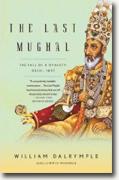The Last Mughal
William Dalrymple
book reviews:
· general fiction
· chick lit/romance
· sci-fi/fantasy
· graphic novels
· nonfiction
· audio books
· author interviews
· children's books @
curledupkids.com
· DVD reviews @
curledupdvd.com
newsletter
win books
buy online
links
home
for authors
& publishers
for reviewers

 |
The Last Mughal: The Fall of a Dynasty: Delhi, 1857 William Dalrymple Vintage Paperback 592 pages March 2008 |
|
William Dalrymple’s The Last Mughal
The remarkable thing about Dalrymple’s account is its sources. While he does draw from conventional accounts, he also uses “lost” sources that are being used for the first time. Dalrymple is effusive regarding “The Mughal Papers,” documents that show the Uprising from the Indian point of view. In this way, Dalrymple manages to composes a new, more complete picture of an important part of Indian history. He tries to make The Last Mughal This is an important book for people wishing to understand the plight facing India today. Many Hindus today speak negatively of the Mughals, of the Muslims lording over the Hindus in India. However, in the 1800s, the Hindus saw the Mughals as the legitimate leaders of India. It is telling that although the Uprising was a mostly Hindu rebellion, they asked for the blessings of the Muslim leader of India. It is clear that Muslims and Hindus once lived side by side peaceably; Hindus attended Muslim madrassas, which were legitimate schools. So what happened to this friendship? Dalrymple ascribes this change to the “divide and rule” strategy of the British. Though this book is excellently written and full of rich detail, The Last Mughal: The Fall of a Dynasty: Delhi, 1857 Still, The Last Mughal Originally published on Curled Up With A Good Book at www.curledup.com. © Swapna Krishna, 2009 |
|
|
|
 Click here to learn more about this month's sponsor! |
|
| fiction · sf/f · comic books · nonfiction · audio newsletter · free book contest · buy books online review index · links · · authors & publishers reviewers |
|
| site by ELBO Computing Resources, Inc. | |
 The power of the Mughals had also eroded drastically by the time the Uprising occurred. At its height, the Mughal empire controlled the entire Indian subcontinent. By Zafar’s time, he barely had power over the Red Fort in Delhi. Though the East India Trading Company had to have Zafar’s permission in order to operate in India, they actually held most of the power by this point.
The power of the Mughals had also eroded drastically by the time the Uprising occurred. At its height, the Mughal empire controlled the entire Indian subcontinent. By Zafar’s time, he barely had power over the Red Fort in Delhi. Though the East India Trading Company had to have Zafar’s permission in order to operate in India, they actually held most of the power by this point.